Comprehensive Guide to Flattening Arrays in NumPy: Mastering numpy flatten array Techniques
numpy flatten array is a powerful technique used in data manipulation and preprocessing. This article will explore the various methods and applications of flattening arrays in NumPy, providing detailed explanations and practical examples to help you master this essential skill.
Understanding numpy flatten array Basics
numpy flatten array is a process of converting a multi-dimensional array into a one-dimensional array. This operation is crucial in many data processing tasks, especially when working with complex datasets or preparing data for machine learning algorithms.
Let’s start with a simple example to illustrate the basic concept of numpy flatten array:
import numpy as np
# Create a 2D array
arr_2d = np.array([[1, 2, 3], [4, 5, 6]])
print("Original 2D array:")
print(arr_2d)
# Flatten the array
flattened = arr_2d.flatten()
print("\nFlattened array:")
print(flattened)
# Verify the shape
print("\nShape of flattened array:", flattened.shape)
print("numpyarray.com")
Output:
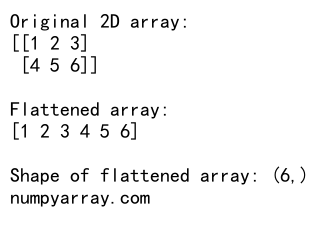
In this example, we create a 2D array and use the flatten() method to convert it into a 1D array. The resulting flattened array contains all the elements from the original array in a single dimension.
Exploring Different Methods for numpy flatten array
There are several methods available in NumPy to achieve the numpy flatten array operation. Let’s explore each of them in detail.
1. Using numpy flatten array Method
The flatten() method is the most straightforward way to flatten an array in NumPy. It returns a copy of the array collapsed into one dimension.
import numpy as np
# Create a 3D array
arr_3d = np.array([[[1, 2], [3, 4]], [[5, 6], [7, 8]]])
print("Original 3D array:")
print(arr_3d)
# Flatten the array
flattened = arr_3d.flatten()
print("\nFlattened array:")
print(flattened)
print("\nShape of flattened array:", flattened.shape)
print("numpyarray.com")
Output:
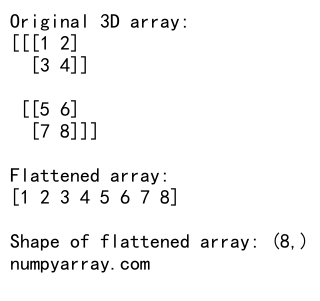
In this example, we flatten a 3D array into a 1D array. The flatten() method works on arrays of any dimension, making it versatile for various scenarios.
2. Using numpy ravel array Method
The ravel() method is another way to achieve numpy flatten array. Unlike flatten(), ravel() returns a view of the original array when possible, which can be more memory-efficient.
import numpy as np
# Create a 2D array
arr_2d = np.array([[1, 2, 3], [4, 5, 6]])
print("Original 2D array:")
print(arr_2d)
# Ravel the array
raveled = arr_2d.ravel()
print("\nRaveled array:")
print(raveled)
print("\nShape of raveled array:", raveled.shape)
print("numpyarray.com")
Output:

In this example, we use ravel() to flatten a 2D array. The result is similar to flatten(), but ravel() may return a view instead of a copy, which can be beneficial for large arrays.
3. Using numpy reshape Method for numpy flatten array
The reshape() method can also be used to flatten an array by specifying -1 as the new shape.
import numpy as np
# Create a 3D array
arr_3d = np.array([[[1, 2], [3, 4]], [[5, 6], [7, 8]]])
print("Original 3D array:")
print(arr_3d)
# Reshape to flatten the array
flattened = arr_3d.reshape(-1)
print("\nFlattened array using reshape:")
print(flattened)
print("\nShape of flattened array:", flattened.shape)
print("numpyarray.com")
Output:
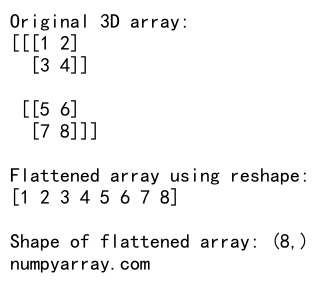
In this example, we use reshape(-1) to flatten a 3D array. The -1 argument tells NumPy to automatically calculate the appropriate size for the new dimension.
Advanced numpy flatten array Techniques
Now that we’ve covered the basics, let’s explore some advanced techniques for numpy flatten array operations.
1. Flattening with Order Specification
Both flatten() and ravel() methods allow you to specify the order in which elements are flattened.
import numpy as np
# Create a 2D array
arr_2d = np.array([[1, 2, 3], [4, 5, 6]])
print("Original 2D array:")
print(arr_2d)
# Flatten with 'C' order (row-major)
flattened_c = arr_2d.flatten('C')
print("\nFlattened array (C order):")
print(flattened_c)
# Flatten with 'F' order (column-major)
flattened_f = arr_2d.flatten('F')
print("\nFlattened array (F order):")
print(flattened_f)
print("numpyarray.com")
Output:
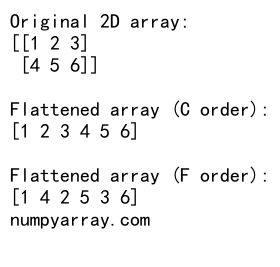
In this example, we demonstrate flattening with ‘C’ (row-major) and ‘F’ (column-major) orders. The ‘C’ order is the default and flattens row by row, while ‘F’ order flattens column by column.
2. Partial Flattening with numpy flatten array
Sometimes, you may want to flatten only certain dimensions of an array. This can be achieved using reshape() with carefully chosen parameters.
import numpy as np
# Create a 3D array
arr_3d = np.array([[[1, 2], [3, 4]], [[5, 6], [7, 8]]])
print("Original 3D array:")
print(arr_3d)
# Partially flatten the array (keep the first dimension)
partially_flattened = arr_3d.reshape(arr_3d.shape[0], -1)
print("\nPartially flattened array:")
print(partially_flattened)
print("\nShape of partially flattened array:", partially_flattened.shape)
print("numpyarray.com")
Output:

In this example, we partially flatten a 3D array by keeping the first dimension intact and flattening the rest. This technique is useful when you want to preserve certain structural aspects of your data.
3. Flattening Structured Arrays
NumPy’s structured arrays can also be flattened, but the process requires special attention.
import numpy as np
# Create a structured array
dt = np.dtype([('name', 'U10'), ('age', 'i4'), ('weight', 'f4')])
structured_arr = np.array([('Alice', 25, 55.5), ('Bob', 30, 70.2)], dtype=dt)
print("Original structured array:")
print(structured_arr)
# Flatten the structured array
flattened = structured_arr.flatten()
print("\nFlattened structured array:")
print(flattened)
print("\nShape of flattened array:", flattened.shape)
print("numpyarray.com")
Output:
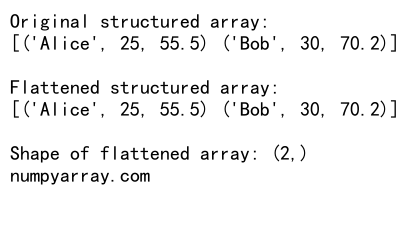
In this example, we flatten a structured array. Note that the flattened array retains the structure of each element, resulting in a 1D array of structured elements.
Practical Applications of numpy flatten array
numpy flatten array operations have numerous practical applications in data science and scientific computing. Let’s explore some common use cases.
1. Preparing Data for Machine Learning
Flattening arrays is often necessary when preparing data for machine learning algorithms that expect input in a specific format.
import numpy as np
# Create a dataset of images (3D array)
images = np.random.rand(10, 28, 28) # 10 images of 28x28 pixels
print("Original image dataset shape:", images.shape)
# Flatten images for a machine learning model
flattened_images = images.reshape(images.shape[0], -1)
print("\nFlattened image dataset shape:", flattened_images.shape)
print("numpyarray.com")
Output:
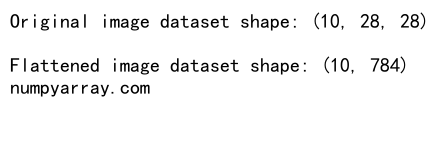
In this example, we simulate a dataset of images and flatten each image while preserving the number of samples. This is a common preprocessing step for many machine learning models.
2. Calculating Global Statistics
Flattening can be useful when you need to calculate global statistics across all elements of a multi-dimensional array.
import numpy as np
# Create a 3D array representing daily temperatures in different cities
temperatures = np.random.randint(0, 40, size=(7, 5, 24)) # 7 days, 5 cities, 24 hours
print("Temperature data shape:", temperatures.shape)
# Calculate global statistics
global_mean = np.mean(temperatures.flatten())
global_max = np.max(temperatures.flatten())
global_min = np.min(temperatures.flatten())
print(f"\nGlobal mean temperature: {global_mean:.2f}")
print(f"Global maximum temperature: {global_max}")
print(f"Global minimum temperature: {global_min}")
print("numpyarray.com")
Output:
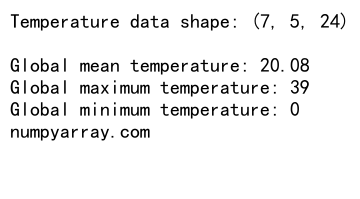
In this example, we use numpy flatten array to calculate global statistics across a 3D array of temperature data, giving us insights into the overall temperature trends.
3. Vectorizing Operations
Flattening arrays can be useful when vectorizing operations that are designed to work on 1D arrays.
import numpy as np
def custom_operation(x):
return np.sin(x) + np.cos(x)
# Create a 2D array
arr_2d = np.array([[1, 2, 3], [4, 5, 6]])
print("Original 2D array:")
print(arr_2d)
# Apply the custom operation to the flattened array
result = custom_operation(arr_2d.flatten())
# Reshape the result back to the original shape
result_2d = result.reshape(arr_2d.shape)
print("\nResult after applying custom operation:")
print(result_2d)
print("numpyarray.com")
Output:
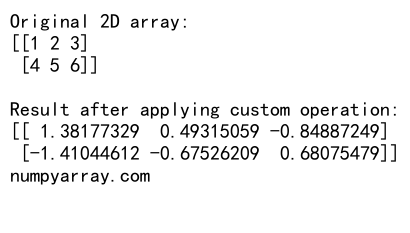
In this example, we apply a custom operation to a flattened array and then reshape the result back to the original shape. This approach can be more efficient than applying the operation element-wise to the original multi-dimensional array.
Handling Large Arrays with numpy flatten array
When dealing with large arrays, memory usage becomes a crucial consideration. Let’s explore some techniques for efficiently flattening large arrays.
1. Using numpy ravel array for Memory Efficiency
For large arrays, using ravel() instead of flatten() can be more memory-efficient, as it returns a view when possible.
import numpy as np
# Create a large 3D array
large_arr = np.random.rand(100, 100, 100)
print("Original array shape:", large_arr.shape)
# Use ravel() for memory-efficient flattening
flattened = large_arr.ravel()
print("\nFlattened array shape:", flattened.shape)
# Check if it's a view
print("Is a view:", flattened.base is large_arr)
print("numpyarray.com")
Output:
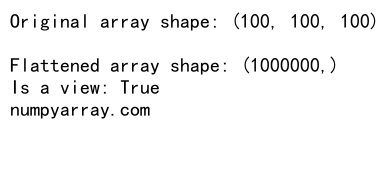
In this example, we use ravel() to flatten a large 3D array. The base attribute helps us confirm whether the result is a view of the original array.
2. Iterative Flattening for Very Large Arrays
For extremely large arrays that don’t fit in memory, you might need to flatten them in chunks.
import numpy as np
def chunk_flatten(arr, chunk_size=1000000):
for i in range(0, arr.size, chunk_size):
yield arr.flat[i:i + chunk_size]
# Create a large 3D array
large_arr = np.random.rand(500, 500, 500)
print("Original array shape:", large_arr.shape)
# Flatten in chunks
flattened_chunks = chunk_flatten(large_arr)
# Process the flattened chunks
for i, chunk in enumerate(flattened_chunks):
print(f"Processing chunk {i+1}, size: {len(chunk)}")
# Perform operations on the chunk here
print("numpyarray.com")
Output:

In this example, we define a generator function chunk_flatten that yields flattened chunks of the array. This approach allows processing very large arrays without loading the entire flattened array into memory at once.
Advanced numpy flatten array Scenarios
Let’s explore some advanced scenarios where numpy flatten array operations can be particularly useful or challenging.
1. Flattening Arrays with Object dtype
Arrays with object dtype require special consideration when flattening.
import numpy as np
# Create an array of Python objects
obj_arr = np.array([[['a', 'b'], ['c', 'd']], [['e', 'f'], ['g', 'h']]], dtype=object)
print("Original object array:")
print(obj_arr)
# Flatten the object array
flattened = obj_arr.flatten()
print("\nFlattened object array:")
print(flattened)
print("numpyarray.com")
Output:

In this example, we flatten an array of Python objects. Note that theCertainly! Here’s the continuation of the article:
In this example, we flatten an array of Python objects. Note that the flattening operation preserves the object references, which can be important when working with complex data structures.
2. Flattening Masked Arrays
NumPy’s masked arrays can also be flattened, but the mask needs to be handled appropriately.
import numpy as np
import numpy.ma as ma
# Create a masked array
arr = np.array([[1, 2, 3], [4, 5, 6]])
mask = np.array([[True, False, True], [False, True, False]])
masked_arr = ma.masked_array(arr, mask)
print("Original masked array:")
print(masked_arr)
# Flatten the masked array
flattened = masked_arr.flatten()
print("\nFlattened masked array:")
print(flattened)
print("numpyarray.com")
Output:

In this example, we flatten a masked array. The resulting flattened array preserves the mask information, allowing you to continue working with masked data in a flattened format.
3. Flattening Arrays with Custom dtypes
When working with arrays that have custom dtypes, flattening operations need to be handled carefully.
import numpy as np
# Define a custom dtype
dt = np.dtype([('name', 'U10'), ('age', 'i4'), ('height', 'f4')])
# Create an array with the custom dtype
arr = np.array([('Alice', 25, 1.65), ('Bob', 30, 1.80)], dtype=dt)
print("Original array with custom dtype:")
print(arr)
# Flatten the array
flattened = arr.flatten()
print("\nFlattened array:")
print(flattened)
print("numpyarray.com")
Output:
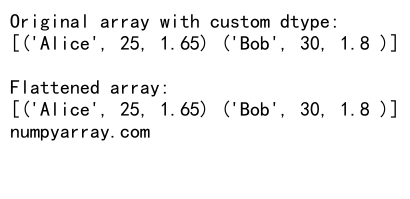
In this example, we flatten an array with a custom dtype. The flattening operation preserves the structure of each element, resulting in a 1D array of structured elements.
numpy flatten array in Data Analysis and Visualization
numpy flatten array operations play a crucial role in data analysis and visualization tasks. Let’s explore some common scenarios where flattening is useful in these contexts.
1. Histogram Creation
Flattening is often used when creating histograms from multi-dimensional data.
import numpy as np
import matplotlib.pyplot as plt
# Create a 2D array of data
data_2d = np.random.normal(size=(100, 100))
print("Original data shape:", data_2d.shape)
# Flatten the data for histogram
flattened_data = data_2d.flatten()
# Create and plot the histogram
plt.hist(flattened_data, bins=50)
plt.title('Histogram of Flattened 2D Data')
plt.xlabel('Value')
plt.ylabel('Frequency')
plt.savefig('histogram.png')
plt.close()
print("\nHistogram created and saved as 'histogram.png'")
print("numpyarray.com")
In this example, we flatten a 2D array of normally distributed data to create a histogram, which provides insights into the overall distribution of values.
2. Feature Extraction for Machine Learning
Flattening is often used in feature extraction for machine learning models, especially with image data.
import numpy as np
from sklearn.decomposition import PCA
# Create a dataset of 100 images (28x28 pixels each)
images = np.random.rand(100, 28, 28)
print("Original image dataset shape:", images.shape)
# Flatten images for PCA
flattened_images = images.reshape(images.shape[0], -1)
print("Flattened image dataset shape:", flattened_images.shape)
# Apply PCA
pca = PCA(n_components=50)
pca_result = pca.fit_transform(flattened_images)
print("PCA result shape:", pca_result.shape)
print("numpyarray.com")
Output:
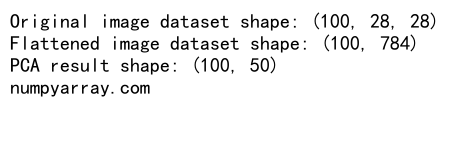
In this example, we flatten a dataset of images to prepare it for Principal Component Analysis (PCA), a common dimensionality reduction technique in machine learning.
Conclusion: Mastering numpy flatten array Techniques
Throughout this comprehensive guide, we’ve explored the various aspects of numpy flatten array operations, from basic concepts to advanced techniques and practical applications. Let’s summarize the key points:
- numpy flatten array is a fundamental operation in NumPy for converting multi-dimensional arrays into one-dimensional arrays.
- There are multiple methods to achieve flattening, including
flatten(),ravel(), andreshape(), each with its own characteristics and use cases. - Advanced techniques like partial flattening and handling structured arrays provide flexibility in dealing with complex data structures.
- Flattening operations are crucial in various data processing tasks, including preparing data for machine learning, calculating global statistics, and vectorizing operations.
- When working with large arrays, memory efficiency and performance optimization become important considerations.
- numpy flatten array operations play a significant role in data analysis and visualization tasks, such as creating histograms and extracting features for machine learning models.
By mastering these numpy flatten array techniques, you’ll be well-equipped to handle a wide range of data manipulation tasks efficiently and effectively. Remember to consider the specific requirements of your data and the operations you need to perform when choosing the most appropriate flattening method.
As you continue to work with NumPy and data analysis, keep exploring and experimenting with these techniques to find the most efficient solutions for your specific use cases. The versatility and power of numpy flatten array operations make them an essential tool in any data scientist’s toolkit.